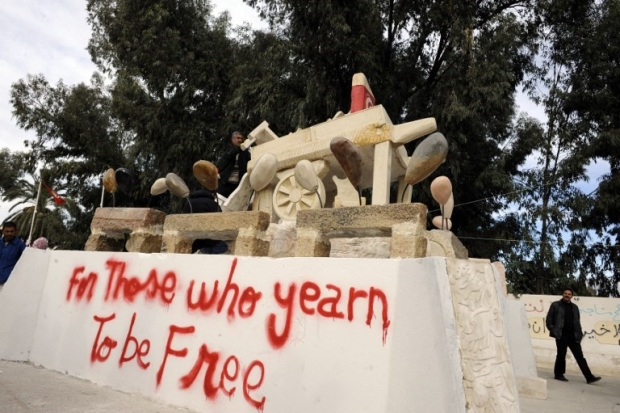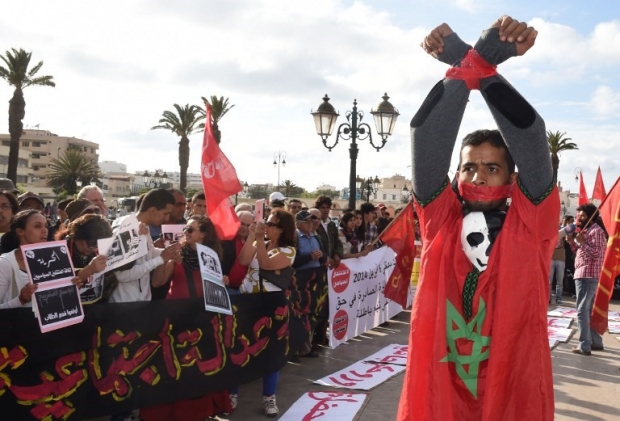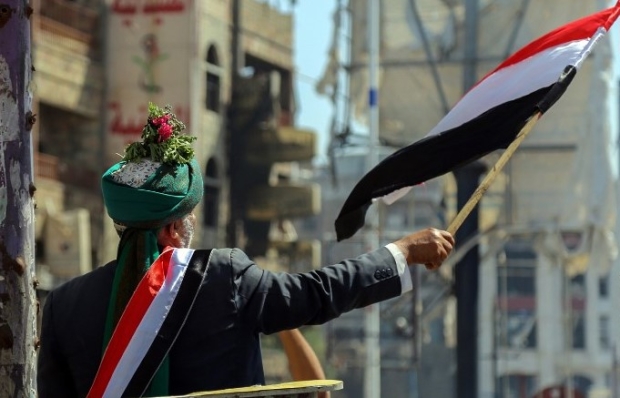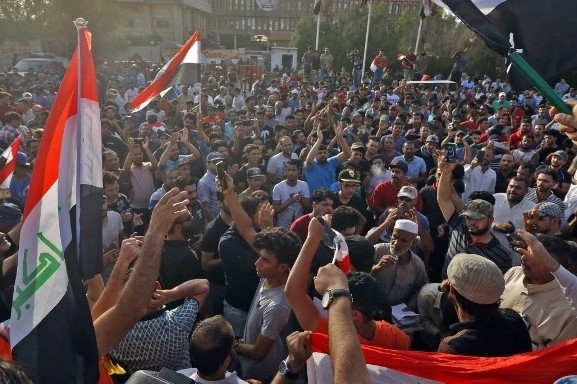Eight years on, the Arab Spring is far from over

When one remembers the exhilarating hope for democratisation and a better Middle East order elicited by the 2011 uprisings, the current political landscape of that region is a truly disheartening one, and the new lexicon of the “post-Arab Spring” or even the "Arab Winter" seems fully justified.
A disastrous landscape
Today, the region seems further than it ever was from the vision of democratised, peaceful, just, prosperous and all-inclusive societies that was the dream of the millions who took to the streets and public squares with immense hope and joy all over the region, from Morocco to Bahrain and from Egypt to Yemen.
It is even hard to imagine this happened only eight years ago - it feels like that breathtaking moment belongs to a bygone historical era.
As a matter of fact, the situation actually looks worse and far more disastrous now than before the self-immolation of the young Tunisian vegetable street seller Mohamed Bouazizi on 17 December 2010, the spark that triggered this historical series of interconnected and symbiotic rebellions and nonviolent revolutions.
The situation actually looks worse and far more disastrous now than before the self-immolation of the young Tunisian vegetable street seller Mohamed Bouazizi on 17 December, 2010
Egypt, whose Tahrir Square had become the most iconic and globally mediatised emblem of the Arab Spring, its crucible, is now firmly under the yoke of an ultra-violent, fascistic and totalitarian despot far worse than his predecessor, Hosni Mubarak. Saudi Arabia, the United Arab Emirates, and Bahrain continue to be ruled by absolute or near-absolute dynastic monarchs.
In the case of Saudi Arabia, the most powerful state of the region and the one with the most extensive outreach, the new one-man rule of reckless Crown Prince Mohammed bin Salman, himself an assassin and one who has committed war crimes in Yemen, constitutes a terrible regression in the nature and exercise of Saudi power, even by the democratically low KSA standards.
Iraq has not even recovered from the eight years of American occupation and the waves of violence provoked by the 2003 US invasion. It is barely coming back to life after three years of Islamic State group savagery.
Palestine: Terminal dead-end
The Israeli-Palestinian situation has reached a terminal dead-end, essentially due to Israel’s (and its allies’) determination to prevent the creation of a Palestinian state, to its continued, brutal colonisation at gunpoint, to its now open Jewish absolutist supremacism, and to the Trump administration, the most unconditionally and exclusively pro-Israel of all US administrations since the creation of Israel.
The Palestinian people seems fully abandoned by all, including the US, the EU and most Arab states, now that MBS has aligned the Saudi kingdom with Israel.
Tunisia, the one Arab Spring success story and the exception that confirms the rule, has been for years in a fragile and volatile situation
Even Tunisia, the one Arab Spring success story and the exception that confirms the rule, has been for years in a fragile and volatile situation, its various and precarious post-revolutionary governments, though genuinely committed to democracy, utterly incapable of solving the dramatic economic problems that plague this nation and risk endangering its democratic future as well.
Meanwhile, relatively better places like Lebanon, Jordan or Kuwait are themselves struggling to stay out of trouble, keep a low profile and avoid getting sucked into the maelstrom of fragmentation, breakdown, and often horrific violence - both state and non-state, both intra-national, trans-national and international - that followed the apparent demise of those attempted revolutions.
Everywhere you look, the situation looks tragic and often truly horrible, with Yemen, Syria and Egypt in the most awful situation.
Why the Arab Spring failed
It is not too hard to understand how we went from such noble and flamboyant dreams of a better Arab order to the nightmares of violence of all sorts we can now observe throughout the region.
The main factor in this sad historical outcome was - without a doubt - the massive and merciless repression soon launched against the uprisings by heads of state like Syria’s President Assad and deep state forces like Egypt’s Supreme Council of the Armed Forces (SCAF).
The main factor in this sad historical outcome was the massive and merciless repression soon launched against the uprisings by state powers from heads of state like Syria’s President Assad to infra-state forces like Egypt’s Supreme Council of the Armed Forces
They clearly understood that for them this was a historic fight for survival, and to that end they immediately mobilised the vast resources - military, economic, political, and propagandistic - at their disposal before it was too late, while supporting each other when it came to quelling those protests in blood, as Saudi Arabia did with Bahrain.
The considerable logistical means they could muster, including their massive security forces, their long experience and skills at repression, their absolute determination at nipping those revolutions in the bud, their strategic intelligence and, alas, excellent and shrewd manoeuvres, completely outplayed the protesters, and when needed, suppressed them in blood.
Those still strong state apparatuses and forces closed ranks to save what could be saved of their rule.
Revolution vs counterrevolution
Faced with such focused, resourceful, intelligent, ruthless and able counterrevolutionary actors and, no matter how many millions had gone to the streets, the revolutionary players and protesters were simply outplayed.
They had no leaders, no real resources other than their bodies, spirit and courage (admirable but weak in front of a bullet), no real programmatic depth or strategic skills. They were very far from the leaders of, say, the French or Soviet revolutions, and they often committed tragic mistakes.
For example, when the Egyptian Tamarrod movement, all dizzy and intoxicated by the stunning and exhilarating initial successes of the Arab Spring, recklessly supported Sisi’s July 2013 military coup against the democratically elected President Mohamed Morsi, they believed - stupidly, it must be said - they could control or keep in check a far more considerable force like SCAF.
As a result of such naivety, the Tamarrod students quickly found themselves sharing cells with their former Muslim Brotherhood bêtes noires, when Sisi - having eliminated Morsi and the Muslim Brotherhood - turned against them too. This was all too predictable without the aid of retrospective vision.
Revolutionary actors had no leaders, no real resources other than their bodies, spirit and courage, no real programmatic depth or strategic skills, and they often committed tragic mistakes
The second reason why the Arab Spring quickly collapsed and ended in either violence or even more brutal autocracies is that the protestors both vastly overestimated themselves, their strengths, their capabilities, while often underestimating the continuing support of large segments of the population for the dictators and regimes they were seeking to topple - as in the case of Syria’s Assad.
In the words of Adam Roberts: “Getting rid of a dictatorial and corrupt ruler is not enough. Building democratic institutions, and restoring confidence in a flawed state, are much harder tasks. It was a failure to understand this that led the US and Britain into their disastrous Iraq adventure in 2003.
"However, it is not only the neocons and their friends who need to learn this lesson. So do advocates and practitioners of nonviolent civil resistance, who have often concentrated on the task of getting rid of dictators with less thought and planning about what comes after.”
Other factors, though minor and not decisive, played a role, such as the complete lack of support from the "free, democratic West", whose leaders, Barack Obama included, paid at best mild and hypocritical lip service to the Arab Spring, before resuming their full support to those repressive states, their new or old autocratic strongmen and despotic tyrants as fast as they could.
Reasons for hope?
Despite the bleak situation of most countries and what has been presented above, there are reasons to hope. The Arab Spring should not be so casually dismissed or characterised as a total failure as most analysts, including the best foreign policy scholars, have been doing for years.
From a political perspective, this can only add to despair and hopelessness, whereas from a historical perspective, such characterisation is only partially true as well as short-sighted, focused too much on the present situation.
First, the toppling of no fewer than four dictators in one single year (Tunisia’s Ben Ali, Egypt’s Mubarak, Libya’s Gaddafi and Yemen’s Saleh) followed by free elections in several countries, the emergence and resilience of at least one genuine democracy (Tunisia, not surprisingly for anyone familiar with that country and its specificities compared to the rest of MENA), and at least some reforms in countries like Morocco should certainly not be regarded as negligible.
The exhilarating experience of the Arab Spring, which for millions was their first taste of freedom and popular sovereignty, remains a foundational moment as well as a model and a continuing source of inspiration
Second, the exhilarating experience of the Arab Spring, which for millions was their first taste of freedom and popular sovereignty, remains a foundational moment as well as a model and a continuing source of inspiration.
Third, it debunked, forever, the notion that had settled even among those populations that the “Arab world” was hopeless, will never be able to achieve freedom and popular sovereignty as much of the world had done, and as such was a sort of geographical-cultural exception.
Fourth, it showed that those despotic regimes, which many thought were unshakable or at least strong and stable, were actually paper tigers that could be challenged and defeated. And if since, heads of states like Sisi, Assad or MBS have been repressing any sign of dissent with the brutality we have witnessed, they have done so out of fear, even despair, because after feeling the heat, they know they are much more fragile than the appearance of strength and confidence they seek to project would suggest.
But the utopian imagination has always been a fundamental feature of humanity, and the Arab Spring remains a major and integral part of that active imagination, though it may seem dormant for the moment.
Fifth, it is factually incorrect to say the Arab Spring is over since there is no shortage of places where it continues, albeit on a smaller scale and in localised, less spectacular, and in different forms.
Active source of inspiration
Despite the economic hardship, the Tunisian people have not lost any of their democratic commitment and will to oppose and fight autocratic, repressive and corrupt Arab leaders, as MBS discovered during his trip there earlier this month even when he was trying to buy their silence.
In Tunisia, the Arab Spring remains an active source of inspiration and a powerful driver for more protests though the situation is much freer than under bin Ali, at least politically.
In Syria, the opposition to Assad continues, and contrary to the image perpetrated by the media, it is by no means limited to armed “Jihadism”. Though disunited, the opposition parties perpetuate a non-violent resistance to the regime. Most of the Assad opponents are neither "Jihadists" nor "Islamists", and millions of Syrians remain committed to a civil, democratic and all-inclusive future for their country.
Jordan itself has seen new waves of mass protests fuelled by the same claims, frustrations, needs and spirit as those of the Arab Spring. As David Hearst writes: “It's what happens to a people who have had enough of skyrocketing prices, a contracting economy, crony government, false elections, fake parties - the whole panoply of ills of the modern Arab state.”
A mix of appeasement and repression
In Morocco, a combination of political authoritarianism, economic stagnation, a poor economy, and a demographic boom (namely the same factors that caused the Arab Spring) has been creating an increasingly restless youth who no longer hesitates to take to the streets with slogans that are openly against King Mohammed VI.
The social and political movement of the Rif, which started in October 2016 and was severely repressed by the regime, has for two years been spreading to other parts of the county, tapping into a very deep well of discontent and political as well as economic needs the government seems both incapable and unwilling to address.
Though the Hirak movement is often presented as highly local and focused on very concrete economic problems such as price hikes and lack of infrastructures in certain parts of the country, there is no doubt that the contestation goes well beyond these local contexts and bread-and-better issues. It is questioning the very nature of the regime and the state itself, what in Western terms we would call “the social contract”. Even the question of a possible post-monarchy Morocco is now no longer a taboo.
In full panic mode, then Prime Minister Haider al-Abadi, another feckless empty suit, deployed a typical mix of brutal state violence - live ammunition was fired against the protesters killing 14 - and empty economic and anti-corruption promises.
But despite this classic mix of appeasement and repression, Abadi, the US State Department’s favourite, did not survive the latest round of Iraqi protests. They dealt him a fatal blow and forced him to resign on 25 October.
Far from over
One could go on and on like this for pages. But those few examples are enough to show the Arab Spring is far from over and that underneath the false appearance of an “Arab Winter”, its ashes are still burning in literally every country of the Middle East-North Africa.
As Merissa Khurma writes regarding the dynamics at work in Jordan, in a comment that applies to the whole region as well: “The Arab Spring as we know it may have ended, but political and social activism hasn’t. Fatigue, in other words, is in the eye of the beholder…The Arab Spring, far from disappearing, has ignited a wave of subsequent pushes for reform."
And if those ongoing movements look more "issue-focused" or reformist than revolutionary, it is nonetheless still in the impassioned language of “Our Revolution”, with the Arab Spring and its “first martyrs” invoked as an explicit model and reference, that those demands for qualitative, radical changes at all economic, social, political and governance levels are being formulated, whether in Tunisia, Morocco or Iraq.
People might be demonstrating for clean water as in Basra, but you just have to scratch below the surface to see and hear they continue to protest and put their bodies on the line for a much larger and all-encompassing just order.
Taken together, these apparently disparate yet coherent and consistent citizenship and dissent movements constitute Act II of the Arab Spring, or more simply, its continuation.
The Arab Spring cannot be over, for the simple reason that everywhere in the Middle East and North Africa, the conditions that created the revolutionary terrain and generated the 2011 uprisings - autocratic and repressive exclusionary regimes, economic hardship, injustice, corruption etc - still largely exist, sometimes in even worse forms, as in Egypt and Syria.
And if, since 2011, those abominable regimes have been able to stay in place or reassert themselves, it is only through increased brutality, repression of dissent, state terrorism, and support from Western and other states (eg Russia with Assad). This status quo, however, is clearly unsustainable and, for that reason, the Arab Spring or whatever else we choose to call it is destined to continue.
It may not take the form of such spectacular, massive and sudden popular uprisings that in 2011 took the world - including the protestors themselves - by surprise. It may be more reformist, gradual, incremental, cyclical, intermittent, and localised, but it will continue, and in fact does so.
- Dr Alain Gabon is an associate professor of French studies based in the United States and the head of the French Department at Wesleyan University. He has written numerous papers and articles on contemporary France and on Islam in Europe and throughout the world for academic journals and think tanks, including Britain's Cordoba Foundation and mainstream media outlets, such as Saphirnews and Les cahiers de l'Islam. His essay entitled ‘Radicalisation islamiste et menace djihadiste en Occident: le double mythe’ appeared in a September 2016 Cordoba Foundation publication.
Note: Some thoughts in this article were first shared in a September 14, 2018 discussion on the Sociology of Islam Academic Network, [email protected].
Opinions expressed in this article are author’s own and do not necessarily reflect the editorial policy of Middle East Eye.
Photo: An Egyptian protester sits on the ground in front of riot policemen during a demonstration against a controversial deal to hand two islands in the Red Sea to Saudi Arabia on 15 April 2016 outside the Journalists' Syndicate in central Cairo (AFP)
This article is available in its entirety in French on Middle East Eye French edition.
New MEE newsletter: Jerusalem Dispatch
Sign up to get the latest insights and analysis on Israel-Palestine, alongside Turkey Unpacked and other MEE newsletters
Middle East Eye delivers independent and unrivalled coverage and analysis of the Middle East, North Africa and beyond. To learn more about republishing this content and the associated fees, please fill out this form. More about MEE can be found here.










